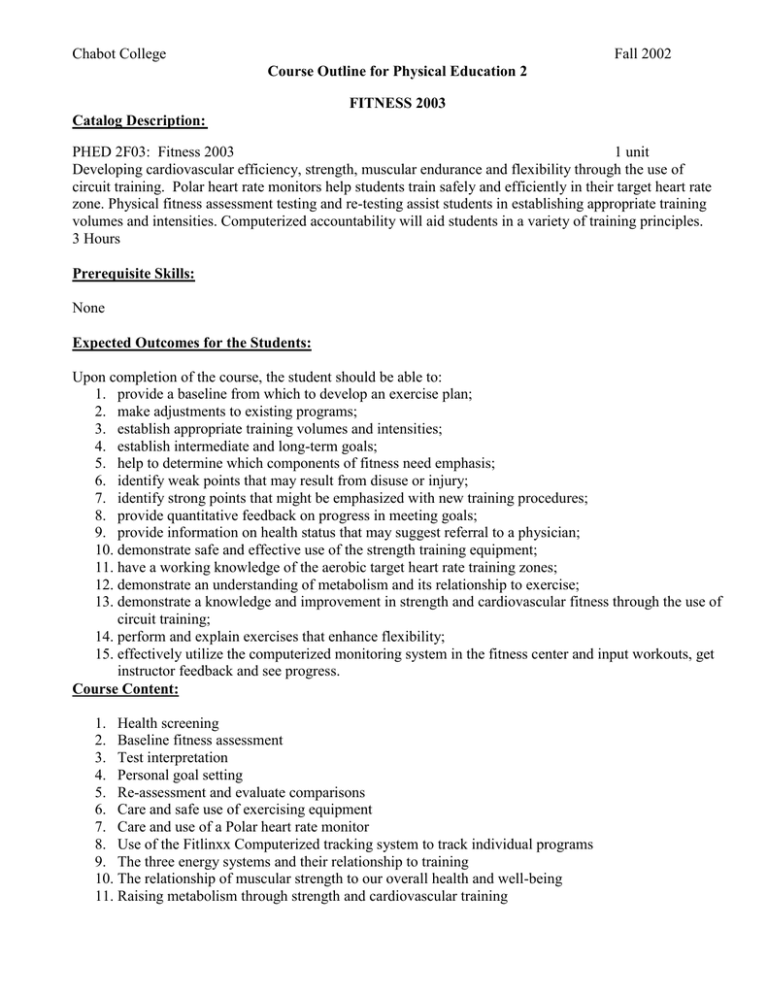Chabot College Fall 2002 PHED 2F03: Fitness 2003
advertisement

Chabot College Fall 2002 Course Outline for Physical Education 2 FITNESS 2003 Catalog Description: PHED 2F03: Fitness 2003 1 unit Developing cardiovascular efficiency, strength, muscular endurance and flexibility through the use of circuit training. Polar heart rate monitors help students train safely and efficiently in their target heart rate zone. Physical fitness assessment testing and re-testing assist students in establishing appropriate training volumes and intensities. Computerized accountability will aid students in a variety of training principles. 3 Hours Prerequisite Skills: None Expected Outcomes for the Students: Upon completion of the course, the student should be able to: 1. provide a baseline from which to develop an exercise plan; 2. make adjustments to existing programs; 3. establish appropriate training volumes and intensities; 4. establish intermediate and long-term goals; 5. help to determine which components of fitness need emphasis; 6. identify weak points that may result from disuse or injury; 7. identify strong points that might be emphasized with new training procedures; 8. provide quantitative feedback on progress in meeting goals; 9. provide information on health status that may suggest referral to a physician; 10. demonstrate safe and effective use of the strength training equipment; 11. have a working knowledge of the aerobic target heart rate training zones; 12. demonstrate an understanding of metabolism and its relationship to exercise; 13. demonstrate a knowledge and improvement in strength and cardiovascular fitness through the use of circuit training; 14. perform and explain exercises that enhance flexibility; 15. effectively utilize the computerized monitoring system in the fitness center and input workouts, get instructor feedback and see progress. Course Content: 1. Health screening 2. Baseline fitness assessment 3. Test interpretation 4. Personal goal setting 5. Re-assessment and evaluate comparisons 6. Care and safe use of exercising equipment 7. Care and use of a Polar heart rate monitor 8. Use of the Fitlinxx Computerized tracking system to track individual programs 9. The three energy systems and their relationship to training 10. The relationship of muscular strength to our overall health and well-being 11. Raising metabolism through strength and cardiovascular training Chabot College Course Outline for Fitness 2003 - PHED 2F03, Page 2 Methods of Presentation: Each semester, all students must attend orientation sessions on the proper use of all exercise equipment and a battery of physical fitness assessments. Late adds will view a video tape of the orientation and make an appointment for a Fitlinxx orientation as well as scheduling for the assessment center Each student will be assessed in the following areas: 1. Resting blood pressure; 2. Body weight; 3. Body composition by the use of near-infrared interactance; 4. Spinal flexion reach; 5. Upper body strength by the use of a Cybex chest press; 6. Lower body strength by the use of a Cybex leg press; 7. Muscular endurance by the number of push-ups; 8. Muscular endurance by the number of sit-ups; 9. Cardiorespiratory endurance by the Astrand-Rhyming cycle ergometer test or Step Test. After completing a pre-test, and exercise prescription will be recommended for each student using a combination of circuit training, aerobic training and strength training. Assignments and Methods of Evaluating Student Progress: 1. Typical Assignments a. Class discussion and participation b. Demonstration 2. Methods of Evaluating Student Progress a. Participation b. Assessment Textbook: None Special Student Material: 1. 2. 3. 4. 5. 6. The student must wear the appropriate physical education attire The student must bring his/her student ID card The student must bring a heart rate monitor strap The student must bring a towel The student must complete the minimum number of exercises each class session The student must enter all exercise information into the Fitlinxx System KC – [U:\kc’document\course outline\pe_2F03.doc] May 2002 2



